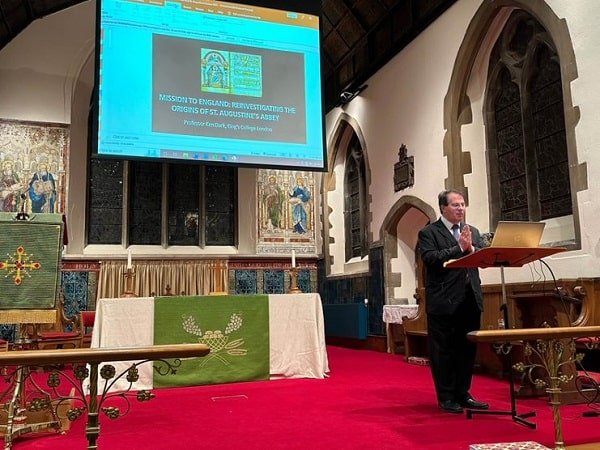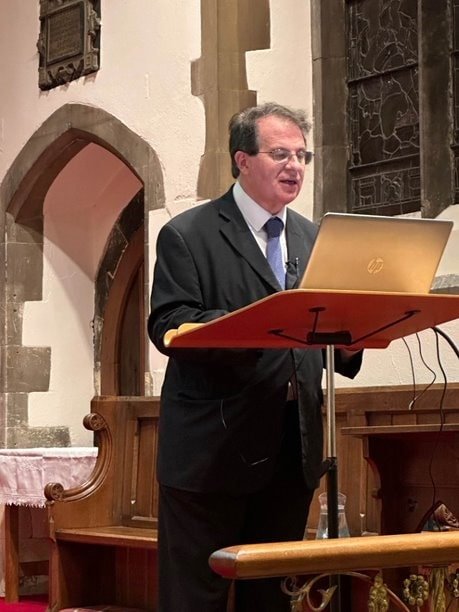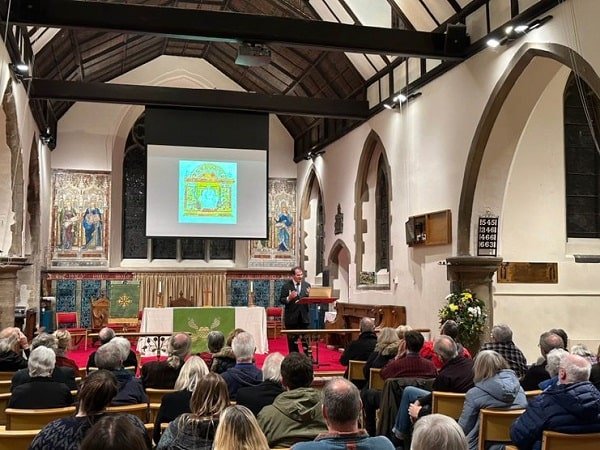
Mission to England: Reinvestigating the Origins of St Augustine’s Abbey
Contributions to the news blog are welcome. See the guidance for contributors and contact Digital Manager Jacob Scott.
Search page
Search within this page here, search the collection page or search the website.
Start of Lees Court Estate Project season 2023
First meeting of the Maritime Kent Special Interest Group
Mission to England: Reinvestigating the Origins of St Augustine’s Abbey
A talk by Professor K.R. Dark of Kings College London was given on 7th February 2023 entitled 'Mission to England: reinvestigating the origins of St. Augustine’s Abbey'.
A large audience gathered in St Paul’s church, Canterbury, before Professor Kerry Brown, as Chair of Trustees of Kent Archaeological Society, introduced Professor Ken Dark. He began his talk by providing some background information about the late Roman period and the importance of Byzantine rule and cultural influence on Italy and north Africa in the early 6th century, for he sees Augustine’s mission to Anglo-Saxon England as coming out of this context.

The opening of Professor K.R. Dark's talk at St Paul’s church, Canterbury on the evening of 7th February.
Turning next to where Bertha, as a Christian Merovingian lady, worshipped after her marriage to Æthelberht had brought her to Kent, he sees St Martin’s as the mostly likely place, and he supports the proposition that the building was probably a re-purposed Roman mausoleum. The idea that it was Bertha’s church before 597 is generally agreed, the case strengthened by the finding of her chaplain Liudhard’s pendant, but the latter proposal has some critics, instead seeing it as having been constructed as a chapel for the use of Bertha and her entourage.
Looking next at the St Augustine’s Abbey site, as at St Martin’s, there has been little recent archaeological work, albeit Professor Dark has found surveys in the English Heritage archive which had seemingly been ‘lost’ and he has now incorporated these findings into his published analysis. Thus his ‘Mission to England’ project, begun in 2018, is drawing on these surveys, as well as the notes from archaeological excavations undertaken in the late 19th and early 20th centuries and those from the 1950s and 1970s. In addition, Professor Dark has compiled a detailed photographic record of the surviving structures, especially the chapel of St Pancras as he and his team seek to reinvestigate the early history of the abbey site after Augustine’s arrival and establishment of the first monastery in Anglo-Saxon England.

Professor K. R. Dark, PhD, FSA, FSA Scot, FRHistS, FRAI, SFHEA.
This brought Professor Dark to the major section of his lecture where he discussed the phasing of the chapel of St Pancras, seeing it as separate from the church dedicated to SS Peter and Paul and that to St Mary because they are on the same but on a different axis to that of St Pancras. His assessment of this latter chapel rests on matters such as the reuse of Roman brick for certain elements, the difference in the colour of the mortar indicative of different phasing, the presence/absence of specific decorative features in association with particular parts of the building, the range of stone used and a few dating features such as an 8th-century coin. Taking all of these together, he has concluded that the chapel should be seen as having been constructed in two distinct phases, it having gone out of use between Phase 1 and Phase 2, that Phase 2 consists of two sub-phases 2a and 2b, and that part of the Phase 1 structure was still standing when Phase 2 was begun because some of the first was incorporated into the second.
Putting all of this together, he sees Phase 2 as late 7th to early 8th century. However, it is the dating of Phase 1 that he especially wanted to highlight to the audience. His argument is that the builders of Phase 1 used the short perch system of measurement, which Professor John Blair sees as an Anglo-Saxon not Merovingian construction method – that used the long perch system, and thus it must post-date Augustine’s arrival. Furthermore, as he explained to his audience, the more elaborate churches on the abbey site on their differently aligned axis come after 609, which means Phase 1 must date from 597 x 609. As he said, he has discussed this in more detail in an article published last year in the Journal of the British Archaeological Association, which is available to download through the Open Access scheme.
Moreover, his project has further objectives and amongst these he will be leading a team of archaeologists and volunteers to re-excavate part of the church of SS Peter and Paul in August 2023. This will involve taking out the gravel from around the tombs of the early archbishops and bishops, detailed surveying and the production of a photographic record, as well as radiocarbon dating some samples. The archaeologists will also re-investigate the Jenkins archive of the earlier excavations, thereby bringing together all that is known about the site. As he said, he is looking for local people to get involved and will be recruiting volunteers soon – a fantastic opportunity for students!
To finish off his lecture, he mentioned two other things that he wants to investigate – a pillar on the abbey site – where did it come from, how long has it been in its present position, does it pre-date the abbey, what might it have been for? His other fascination is the campanile mound. Ok as a place for the monastic bell tower but was it there before the monastery, what is under it, can the archaeologists ‘peel back’ the layers and if so, was it much smaller in Anglo-Saxon times, and even could it be a ship burial? All of this is tantalising and exciting. In the meantime, Professor Dark’s article is available online (see centaur.reading.ac.uk/106464). From the audience’s reaction, it was clear that people had been fascinated, similarly evident from the Q&A session afterwards.

With thanks to the community of St Pauls and St Martins church.
The Society would like to extend thanks to Dr Sheila Sweetinburgh for this summary of the evening and all her help and that of her colleagues at The Centre of Kent History and Heritage in helping to arrange the evening. Grateful thanks is also extended to our student helpers on the night Eli and Leo and to the community of St Pauls and St Martins church who made us most welcome, especially Jackie Curd who gave up her time to open and close the church and generously ran the IT on the night.
